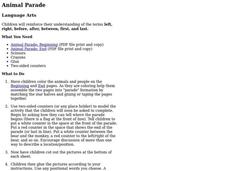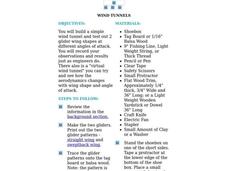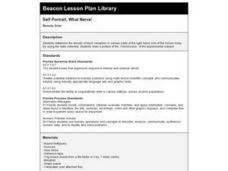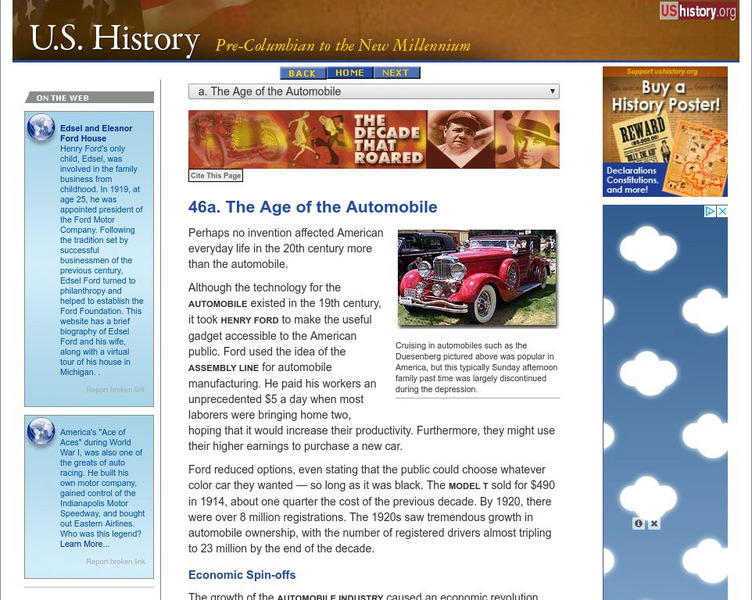Curated OER
Balloon Staging
Pupils discover how rockets can reach a higher altitude by using staging. They use balloons to demonstrate this concept and then practice with rockets. They discuss the results to end the activity.
Curated OER
Animal Parade
Students begin the activity by coloring animals on the beginning and end pages. They are to put the other pages in order based on the animals place in the parade.
Curated OER
Ordering News Reports Lesson 5
Students create a news program with several reports. They examine the newsorthiness of the reports. They include different types of reports in their news program. They consider how the different reports appeal to audiences.
Curated OER
Interview Folder - For the Teacher
In this interview folder for the teacher instructional activity, teachers utilize the checklist to prepare students for conducting interviews and recording the information they capture.
Curated OER
WWII Economics
High schoolers simulate a classroom rationing program resembling an environment similar to the coupon/stamp rations conducted during WWII. The simulation last 3 days resulting in an observable outcome in relationship to the coupon...
Curated OER
Wind Tunnels
Students build a simple wind tunnel and test out 2 glider wing shapes at different angles of attack. They record their observations and results just as engineers do. There also is a "virtual wind tunnel" they can try to test aerodynamic...
Curated OER
Undokai - Japanese Games
Students are introduced to several traditional Japanese sports and games. Students organize an 'Undokai' - a sports day in which they compete in teams.
Curated OER
Self Portrait, What Nerve!
Students conduct an experiment to determine the distance between touch receptor fields in parts of the right-hand side of the body. They enter data into the data table.
Curated OER
Scrumptious Subs
Students distinguish between and convey needed items when speaking to get a desired result.
Curated OER
Flying the Friendly Skies
Students investigate aerodynamics by comparing and contrasting the flight of two gliders. They make prediction and observation charts and test a variety of hypotheses using paper gliders.
Curated OER
Who's the Father?
Students analyze gels to determine parentage in this lesson about scientific evidence, investigation, and DNA concepts. The lesson includes a pre-activity worksheet, a final individual assessment, and student handouts for in-class...
Curated OER
Puzzle Quilts
High schoolers watch a demonstration on how to create a puzzle quilt. Using different fabric combinations, they use each block design twice to create the illusion that each block is unique. They are to determine which blocks are the...
Curated OER
Structures Of Life
Students investigate the basic conceptual structures of plants, with the focus being the parts that contain seeds. They comprehend that organisms that have fruit for the holding of seeds for replication of the species. The students work...
Curated OER
Computer Aided Cubism
Young scholars engage in a study of the artistic style of cubism with the integration of technology to aid them create a unique work of art. They are shown the works of Picasso and Braque in order to serve as examples to create a context.
Curated OER
The Games Divided
In these Olympic history worksheets, students read about the ancient Olympic games and the modern games. Students complete a Venn diagram to compare and contrast the past and present Olympic games.
Curated OER
Waldseemuller's Map: World 1507
Seventh graders analyze various maps. In this Geography lesson, 7th graders create a large map as a whole class. Students write a letter to Mr. Waldseemuller.
TryEngineering
Try Engineering: Assembly Line
The core of this lesson is about the power of mass production. Students will first assemble a product individually, then work in teams to design, build, test, and redesign an assembly line whose product must meet quality control...
PBS
Pbs: Ford Installs First Moving Assembly Line
A look at the history of the assembly line discusses how the use of this tool was initiated by Henry Ford in his Automobile plant.
California Digital Library
Calisphere: Assembly Line
A broad selection of images featuring assembly lines can be found on this site by Calisphere. By clicking on individual images you'll find high quality photographs and image information.
Ducksters
Ducksters: Henry Ford: Father of the Modern Assembly Line
A site that includes Henry Ford's biography. Learn about the inventor of the assembly line and founder of Ford Motor company.
PBS
People's Century: On the Line
An overview of the assembly line and labor before World War II. Read two personal interviews from men who worked for Ford during this era. Includes teaching guide and links to additional resources.
Independence Hall Association
U.s. History: The Age of the Automobile
Henry Ford's use of the assembly line to manufacture his automobiles led to many ramifications. Read about the spin-off industries created by the growth of the automobile industry, and see what impact the auto had on culture.
Council for Economic Education
Econ Ed Link: Lean on Me We Depend on Each Other
Check out this website to learn more about the economy, specialization, and the reasons assembly lines are used.
Khan Academy
Khan Academy: Us History: 1890 1945: 1920s Consumption
In the 1920s, assembly line production and easy credit made it possible for ordinary Americans to purchase many new consumer goods.
Other popular searches
- Assembly Line Activities
- Assembly Line Simulation
- Henry Ford Assembly Line
- Assembly Line Project
- Assembly Line Production
- Ford Assembly Line
- Assembly Line Workers
- Assembly Line Sandwich
- Assembly Line Work
- Assembly Line Carpentry
- 1922 Ford Assembly Line
- Assembly Line Disadvantages

























